Safe Engine Break-In
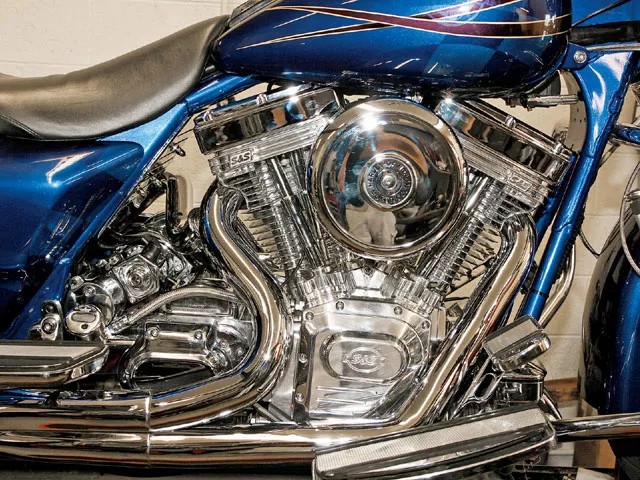
Chester’s Harley-Davidson just completed installation of a new S&S; 124ci Twin-Cam engine with 48mm Mikuni carb into this customized ’01 Road King. Dan Klann, Chester’s lead service technician, was about to begin the engine prestart and initial-start procedures so a few break-in miles could be put on the new engine.
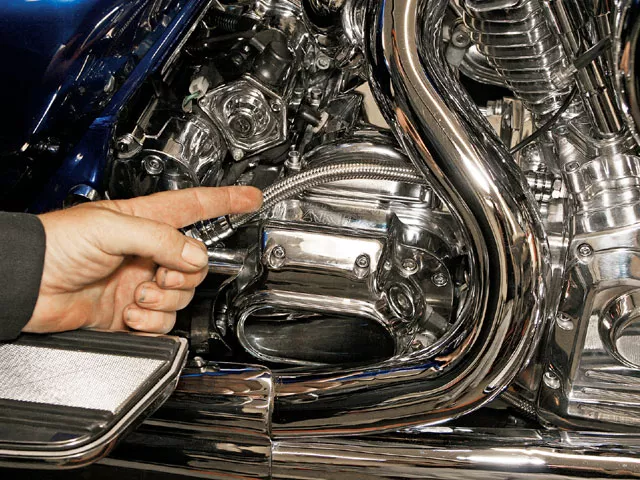
During prestart checkout, the engine’s oil and breather lines were checked for the correct routing and any crimping or loose fittings.
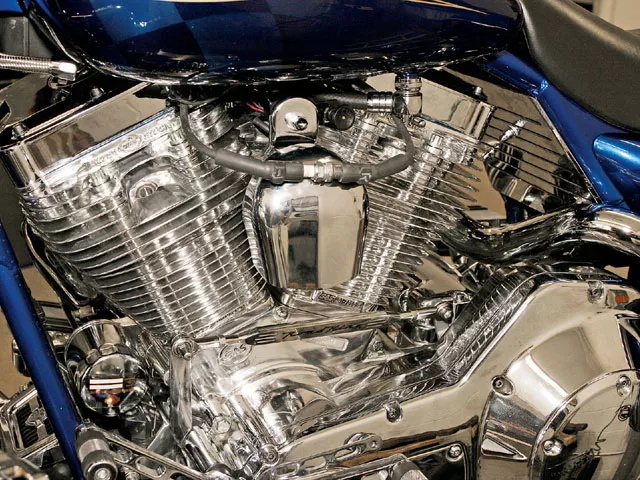
The engine’s oiling system, including hydraulic lifters, must be primed before initial start-up. Remove the spark plugs and connect the plug wires to a spark plug to protect the ignition system while cranking the engine with the electric starter. To check for oil pressure, remove the oil-filter screen plug by the right-side rear lifter block.
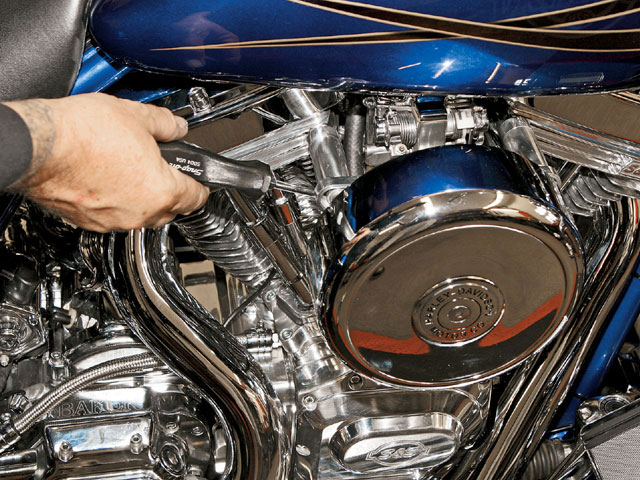
The carburetor or EFI system should be set to the engine manufacturer’s recommendations before initial start-up. Here, the 48mm Mikuni is being adjusted.
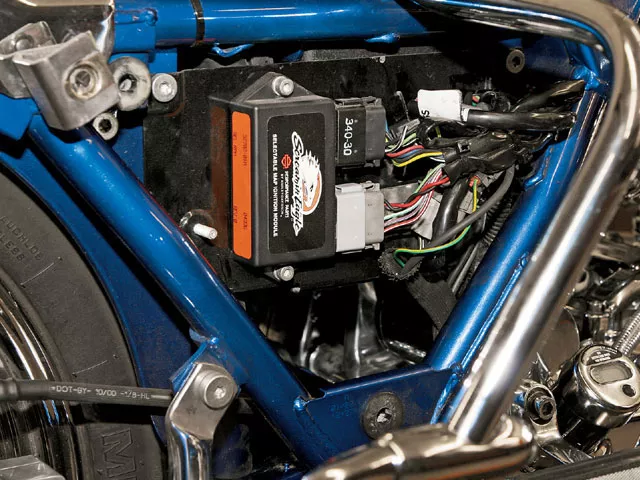
The ignition system must be set according to the engine manufacturer’s recommendations before initial start-up. Excessive ignition advance increases cylinder pressures and heat, which can lead to detonation and engine damage.
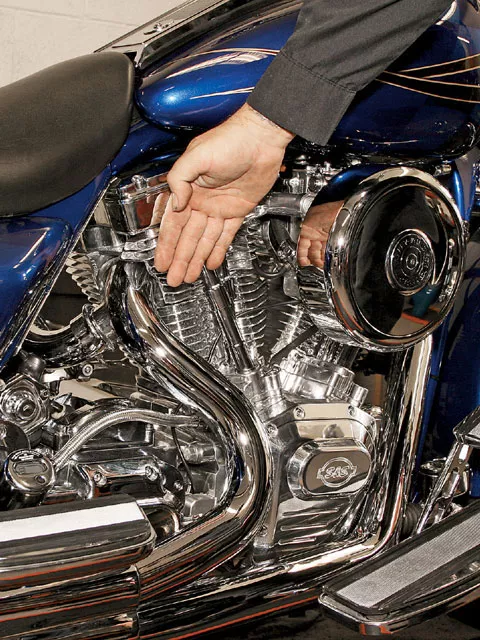
During engine heat cycling, the tops of the cylinders were checked for temperature to determine when to shut off the engine so it can cool. Hot to the touch or about 150 degrees F is about right. Some engine builders prefer to run the engine during heat cycling a predetermined number of seconds instead of checking for cylinder temperature.
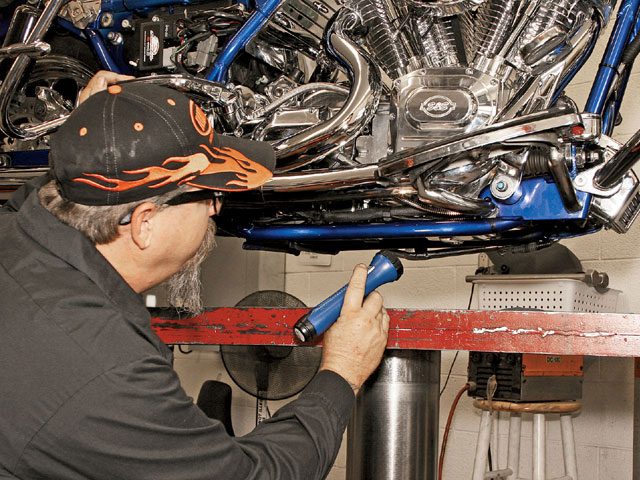
Chester’s Harley-Davidson’s Dan Klann is seen here checking for any oil and gasoline leaks after initial start-up. Dan had just finished assembling the fully polished S&S; 124ci engine and installing it into the customized Road King chassis.
OK, so you just bought yourself a brand-new motorcycle or complete new engine, or you just finished assembling that monster motor in your garage. Human nature being what it is, it’s very tempting to immediately start up your new hot rod and rev it a few times before roaring down the street to impress the neighbors. But if you haven’t followed the recommended engine break-in procedures, you are making a huge mistake.
The purpose for breaking in an engine is to allow components to gently wear against each other and to form proper final running fitment. Piston rings need to seat properly to the cylinder walls to maximize cylinder pressure and optimize power. An improper break-in can score the cylinder walls instead of allowing the rings to slowly conform to the wall surface. Valvetrain components and bearings also need a certain amount of gentle wear for proper mating to protect against galling. However, the wearing of parts introduces metal contamination into the engine’s oil supply. As such, frequent oil and filter changes are necessary during the break-in period to protect against excessive component wear and permanent damage to vital engine parts. Correct engine break-in procedures are important and prevent unnecessary component damage while ensuring long engine life, minimal oil consumption, and maximum power. Engine break-in is divided into four major phases: prestart, initial start-up, run-in, and follow-up.
Prestart requirements include cleaning the oil tank, oil cooler (highly recommended), and oil lines, priming the engine’s oiling system, checking oil pressure, and verifying the correct ignition and carburetor or EFI settings. Never run an engine without an oil filter, so check that one is installed.
Initial start-up is important in the break-in process and includes verifying oil pressure, heat-cycling the engine several times, checking for oil and gasoline leaks, listening for abnormal engine sounds, and maintaining the proper oil level in the tank.
Run-in is the actual time the motorcycle and engine are run on the street (or the engine is run on a dyno or break-in stand) to put either street miles or run time on the engine so parts can gently break in and conform to final fitment clearances. This phase includes several oil and filter changes to flush the engine’s oiling system of contaminants generated through the normal wear and mating of parts. As during initial start-up, checks should be made for oil and gasoline leaks, abnormal engine sounds (including detonation-ping, knock), loose or malfunctioning parts, and proper oil level in the tank.
Follow-up procedures entail rechecking the torque of all accessible engine and chassis fasteners with the exception of the cylinder head bolts. Head bolts are normally not retorqued. Some manufacturers recommend retorquing fasteners at every oil change. Additionally, adjustments to the induction and ignition systems are commonly made at this time to optimize the engine’s tune, and the engine’s oil and filter are changed.
The number of break-in phases you’re responsible for will depend on whether you bought a new motorcycle, a complete or unassembled engine, or whether you built your own engine. For example, if you bought a new motorcycle, prestart and initial start-up functions are performed by the manufacturer, and you would begin break-in procedures by following the manufacturer’s run-in and follow-up procedures. If you purchased a complete assembled engine, you must verify what, if any, break-in procedures were performed by the manufacturer. Some complete new engines are not prerun by the manufacturer. If you had an engine rebuilt by a professional mechanic, the mechanic should have performed prestart and initial start-up procedures. However, there could be exceptions, so you must verify what phases of break-in, if any, have been completed. Be careful not to make any assumptions. On the other hand, if you built the engine, obviously, you are responsible for all four phases of break-in.
Break-In Tips
Always remember that heat is the engine’s chief enemy during break-in. The first 10 to 20 minutes of running are the most critical for an engine, followed by the first 50 to 100 break-in miles. Most engine manufacturers recommend heat-cycling (see sidebar) an engine between four and eight times (10-20 minutes total run time) before putting on any break-in miles. While heat-cycling the engine, it is important to use a large fan for engine cooling during both the run and cool-down periods.
Before initial start-up, the engine’s oil tank and oil lines should be cleaned and debris-free. The lines must also be connected properly and not crimped. Additionally, the oil tank should be topped off, the oiling system primed (including the hydraulic lifters), and the carb (including the accelerator pump) or EFI and ignition systems set to the recommended settings.
It is important to avoid excessively rich air/fuel mixtures, which can remove oil from the cylinder walls. Lean air/fuel mixtures, which quickly increase heat, should also be avoided. The exhaust system, ignition timing, and fuel blend can significantly affect the proper air/fuel mixture. Low-octane fuel and hot weather can lead to damaging detonation, so follow the manufacturer’s recommendation for the minimum fuel octane.
Always be gentle on the engine while putting on break-in miles. Avoid overheating the engine at all cost. Heat is directly related to the amount of run time on the engine, rpm, load, airflow, and ambient temperature. Be sure to vary the engine speed and follow the manufacturer’s mandatory number of break-in miles. Do not lug, accelerate hard, use overdrive Sixth gear, or maintain a steady rpm or stress the engine during the break-in period. Preferably, keep rides relatively short during the first 50-100 miles: fewer than 10 miles for the first couple of rides, and no more than 30 miles or so for the remaining trips. To minimize stress and heat, ride solo, avoid stop-and-go traffic, and do not climb steep grades in high gears using a lot of throttle. Avoid prolonged idling, and do not break in an engine at rallies or events where heavy traffic is unavoidable. Consider installing an oil-temperature gauge, and try to keep oil temperatures low, ideally between approximately 165 and 205 degrees F, although some manufacturers suggest that oil temperatures up to 250 degrees F are acceptable. Note that oil temperatures in a Harley V-Twin engine can easily reach 300 degrees F or more. This is excessively high for any type of oil during the break-in period and too high for petroleum-based oils even after break-in.
Change the engine oil and oil filter frequently during the first 2,000 miles, and use a filter with the proper micron rating for the engine. Some synthetic oils, such as Mobil 1, suggest they can be used during engine break-in. Take note of any special break-in procedures listed on the label of the synthetic oil bottle. Keep in mind, however, that since engine oil is changed frequently during the break-in process, it is much more economical to use a petroleum-based oil than a synthetic. Petroleum-based oil is also highly conducive to the break-in process because the objective is to gently wear in parts to achieve proper mating of surfaces. Additionally, never run the engine without an oil filter, and, if necessary, install an oil cooler with a thermostat to maintain proper oil temperatures. Finally, do not dyno-tune an engine until the break-in process is complete.
Next month we will interview several engine manufacturers and professional engine builders to get their insight and recommendations for engine break-in, so stay tuned.
Heat Cycling
Excessive heat is an engine’s primary enemy during break-in. An engine generates a tremendous amount of heat when it is first started, so the risk for scuffing parts is very high. The amount of heat an engine generates is directly related to the amount of run time on the engine, rpm, load, and airflow over the cylinders. Engine heat is generated not only by combustion but also by friction, and most of the friction is generated by the rings and pistons rubbing against the cylinder walls. Unfortunately, new rings and pistons generate an enormous amount of heat because component surfaces are rough and friction is highest. The first 10 to 20 minutes of run time are the most critical for a new engine; next most critical are the first 50 break-in miles. Fortunately, the engine’s enormous amount of initial friction quickly subsides to more tolerable levels during the first few minutes the engine is run. This is where heat cycling comes into play.
Heat cycling is the process of running an engine for a short period, then shutting it off and allowing it to cool to room temperature. The two-part cycle is then repeated between four and eight times for a total engine run time of 10 to 20 minutes. During each successive cycle, the engine is run for a slightly longer period, because as an engine gains run time, parts gently abrade against each other; consequently, friction is reduced, and so is the heat generated for a given length of run time. The first heat cycle begins at initial engine start-up and includes between 30 seconds and two minutes of engine run time. During successive cycles, run time is increased to about four minutes. A fan should be used for engine cooling during the heat-cycling process.
There are several different methods for heat cycling, and each engine manufacturer has its own philosophies and preferred methods. In particular, some manufacturers recommend performing eight heat cycles. In this case, the engine is run for 30 seconds during the first cycle; then it is shut off and allowed to cool to room temperature. The length of each succeeding cycle’s run time is extended by 30 seconds. For example, the engine is run 30 seconds during the first heat cycle, 60 seconds during the second cycle, 90 seconds during the third cycle, and so forth. During the eighth and final cycle, engine run time will be four minutes. This will result in 18 minutes of total run time during the eight heat cycles. The key point is that the first heat cycle generates the most friction due to the scrubbing effect of the rings on the newly finished cylinder walls. Consequently, the most heat is generated in the shortest amount of time during the first cycle, so its run time is the shortest. Each succeeding cycle generates less friction because engine parts are gradually seating together. Therefore, heat buildup takes slightly longer for each succeeding cycle, and run time can be correspondingly lengthened to generate the same amount of cylinder heat.
Other manufacturers prefer to ignore the 30-second rule, instead running an engine until the tops of the cylinders feel hot to the touch, about 150 degrees F (usually one to four minutes of run time), then shutting off the engine and letting it cool to room temperature. This sequence is then repeated between four and eight times. When the heat-cycling process is completed, the engine is ready for break-in road miles.






